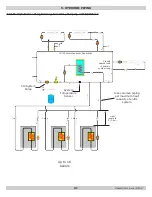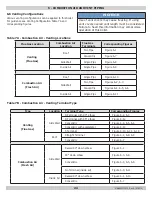
13
5.1 General
• Install piping in accordance with authority having jurisdiction.
NOTICE
Use two (2) wrenches when tightening boiler's
fitting and pipes. Boiler's internal piping can be
damaged if subjected to excessive torque.
• Support system piping and safety relief valve discharge
piping. Boiler's internal piping and wall mount bracket can
be damaged if subjected to excessive weight.
• Size central heating pump (and domestic hot water pump, if
used) for system requirements only.
•
Thoroughly clean and flush system before connecting to
boiler.
• If oil is present in system water, use approved detergent to
wash system.
• Flush system to remove any solid objects such as metal
chips, fibers, or Teflon tape, etc.
5.2 Special Conditions
• System piping exposed to freezing conditions: Use
inhibited propylene glycol solutions certified by fluid
manufacturer for use with closed water heating system.
Do not use automotive or ethylene glycol.
• Boiler used in connection with refrigeration system.
Install piping in parallel with boiler, with appropriate
valves to prevent chilled medium from entering boiler.
• System piping connected to heating coils located in air
handling unit exposed to refrigerated air circulation. Install
flow control valves or other automatic means to prevent
gravity circulation of boiler water during cooling cycle.
5.3 Safety Relief Valve
NOTICE
Boiler rated at 150 psig (1.03 MPa) maximum
allowable working pressure. Boiler provided with 30
psig (206 kPa) safety relief valve. Field source safety
relief valve for system pressures greater than 25 psig.
Temperature Pressure Gauge satisfactory for 60 psig
operation. Field source temperature pressure gauge
for system pressures greater than 60 psig.
•
Install safety relief valve. See figure 5-1
• Install safety relief valve with spindle in vertical position.
• Do not install shutoff valve between boiler and safety
relief valve.
• Install discharge piping from safety relief valve. See
figure 5-2.
• Use ¾" or larger pipe.
• Use pipe suitable for temperatures of 375°F (191°C)
or greater.
WARNING
• Poison hazard. Ethylene glycol is toxic. Do not
use ethylene glycol.
• Never use automotive or standard glycol antifreeze,
even ethylene glycol made for hydronic systems.
• Ethylene glycol can attack gaskets and seals used
in hydronic systems.
• Use only inhibited propylene glycol solutions
certified by fluid manufacturer as acceptable for
use with closed water heating system.
•
Thoroughly clean and flush any system that used
glycol before installing new Boiler.
•
Provide user with Safety Data Sheet (SDS) on fluid
used.
!
NOTICE
Do not expose boiler and condensate piping to
freezing temperatures.
FIGURE 5-1 Safety Relief Valve (Viewed from rear of
boiler)
Safety Relief
Valve
Position Safety Relief Valve to provide
space for discharge piping.
5 - HYDRONIC PIPING
Shown 50/75/100 Model
P/N# 240010615, Rev. E [07/2015]
Summary of Contents for SSV-050
Page 50: ...50 13 TROUBLE SHOOTING P N 240010615 Rev E 07 2015 ...
Page 52: ...52 13 TROUBLE SHOOTING P N 240010615 Rev E 07 2015 ...
Page 64: ...64 14 1 Connection Diagram 050 075 100 MBH 14 WIRING DIAGRAM P N 240010615 Rev E 07 2015 ...
Page 66: ...66 14 3 Connection Diagram 150 200 MBH 14 WIRING DIAGRAM P N 240010615 Rev E 07 2015 ...














































